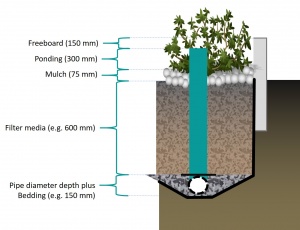Difference between revisions of "Planters: Sizing"
Jump to navigation
Jump to search
Dean Young (talk | contribs) |
Dean Young (talk | contribs) |
||
| (13 intermediate revisions by the same user not shown) | |||
| Line 1: | Line 1: | ||
[[File:Sizing flow-through planter.jpg|thumb|A flow-through planter comprises a ponding zone, mulch layer, filter media for planting, and a supporting gravel drainage layer]] | [[File:Sizing flow-through planter.jpg|thumb|A flow-through planter comprises a ponding zone, mulch layer, filter media for planting, and a supporting gravel drainage layer]] | ||
| − | This article is specific to flow-through [[Stormwater planters| stormwater planters]], vegetated systems that do not infiltrate water to the native soil. <br> | + | This article is specific to flow-through [[Stormwater planters|stormwater planters]], vegetated systems that do not infiltrate water to the native soil. <br> |
If you are designing a planted system which does infiltrate water, see advice on [[Bioretention: Sizing]]. | If you are designing a planted system which does infiltrate water, see advice on [[Bioretention: Sizing]]. | ||
| − | The dimensions of a stormwater planter are largely predetermined according to the function of the component. As they do not contain a storage reservoir the planters rely more upon careful selection of materials. Both the filter media and the perforations of the pipe play critical roles for flow control. | + | The dimensions of a stormwater planter are largely predetermined according to the function of the component. As they do not contain a storage reservoir the planters rely more upon careful selection of materials. Both the filter media and the perforations of the [[Pipe| pipe]] play critical roles for flow control. |
{| class="wikitable" | {| class="wikitable" | ||
| Line 12: | Line 12: | ||
|- | |- | ||
| Ponding (''d<sub>p</sub>'') | | Ponding (''d<sub>p</sub>'') | ||
| − | | | + | | 150 to 450 mm |
| 1 | | 1 | ||
|- | |- | ||
| Line 19: | Line 19: | ||
| | | | ||
* 0.7 for wood based | * 0.7 for wood based | ||
| − | * 0.4 for | + | * 0.4 for stone |
|- | |- | ||
| − | | [[Bioretention: Filter media| | + | | [[Bioretention: Filter media|Filter media]] (''d<sub>m</sub>'') |
| | | | ||
* 300 mm to support turf grass (and accept only rainwater/roof runoff) | * 300 mm to support turf grass (and accept only rainwater/roof runoff) | ||
| − | * 600 mm to support flowering [[perennials]] and decorative [[grasses]] | + | * 600 mm to support shrubs, flowering [[perennials]] and decorative [[grasses]] |
* 1000 mm to support [[trees]] | * 1000 mm to support [[trees]] | ||
| − | | 0.35 | + | | |
| + | * 0.35 for Blend A - Drainage rate priority; | ||
| + | * 0.4 for Blend B - Water quality treatment priority | ||
|- | |- | ||
| Pipe diameter reservoir | | Pipe diameter reservoir | ||
| Line 36: | Line 38: | ||
| 0.4 | | 0.4 | ||
|} | |} | ||
| − | |||
| − | |||
Latest revision as of 20:54, 13 July 2020
This article is specific to flow-through stormwater planters, vegetated systems that do not infiltrate water to the native soil.
If you are designing a planted system which does infiltrate water, see advice on Bioretention: Sizing.
The dimensions of a stormwater planter are largely predetermined according to the function of the component. As they do not contain a storage reservoir the planters rely more upon careful selection of materials. Both the filter media and the perforations of the pipe play critical roles for flow control.
| Component | Recommended depth (with underdrain pipe) | Typical porosity (n) |
|---|---|---|
| Ponding (dp) | 150 to 450 mm | 1 |
| Mulch | 75 ± 25 mm |
|
| Filter media (dm) |
|
|
| Pipe diameter reservoir | Is equal to underdrain pipe diameter | 0.4 |
| Pipe bedding (db) | 50 mm (although commonly omitted altogether). | 0.4 |
